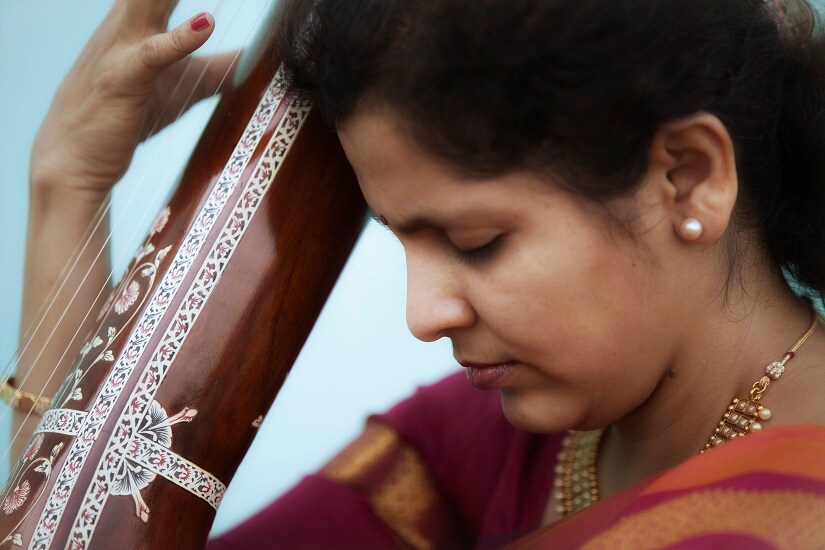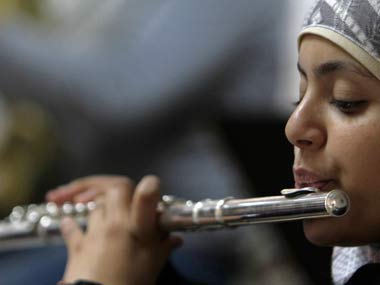On 4 March 2018, just before International Women's Day (8 March), First Edition Arts curates Legacy — a day-long immersive experience of the finest Hindustani music rendered by Apoorva Gokhale (of Gwalior Gharana), Dr Pournima Dhumale (of Agra Gharana) and Pratima Tilak (of Jaipur Gharana). The concerts are presented by First Edition Arts in association with the G5A Foundation for Contemporary Culture.
All the three women, in spite of coming from three distinct gharanas of music, and having had different beginnings seem to converge into the larger narrative of the presence of women in Hindustani classical music.
-Women in music-
Dr Pournima Dhumale, has over the years, shown her mastery over the Agra gharana style of singing. She began her musical training under her mother and musicologist Dr Sulabha Thakar who was herself a disciple of the legendary Hirabai Badodekar. At the age of 25, Dhumale began learning from Babanrao Haldankar, and her tutelage continues till date.
Speaking about women artists in the musical realm and their growth in stature over the years, Dhumale says, "It was a social constraint. Those days the taleem was given to the sons, not the daughters. The education was also passed among the family members and outsiders weren’t allowed. Vilayat Hussian Khan sahib, Khadim Hussain Khan sahib etc have been instrumental in changing this practice. They started teaching women…"
Dhumale specifically mentions the Agra gharana which has a reputation for being male-dominated. She explains, "Agra was essentially a male-dominated gharana. There were hardly any women singers. Now the picture is changing. My guruji (Haldankar) has a major role to play in that. He has taught a number of women performers and now those women are coming ahead. Also, aesthetically saying, since it was a male-dominated gharana, the gayaki (style of singing) was also supposed to be masculine, which is actually not right." Dhumale further adds, "There are certain ragas which are of masculine temperament and there are certain raginis which are of soft temperament. Raga Darbari Kannada sounds good in the male voice, but that doesn’t mean a woman can't sing that. There are many women who perform with deep and heavy voices; I myself have performed Darbari Kannada many times. The gayaki is versatile and it depends on the prakruti (nature) of a raga. It doesn't matter who sings the ragas, as long as the delicacy of that raga is maintained. So with more women coming up, the misconception that Agra gharana is male-dominated will be wiped out completely."
Apoorva Gokhale is one of the torchbearers of the Gwalior gharana style of singing. She is the fifth generation singer in her family of legendary musicians. She has inherited the gift of music from her grandfather, the late Gayanacharya Pandit Gajananrao Joshi, and her great-grandfather Pandit Antubua Joshi, an eminent court musician in the erstwhile state of Aundh, district Satara. Her major training happened under the supervision of her uncle and eminent vocalist-violinist Pandit Madhukarrao Joshi. Simultaneously she also received guidance from her father Shri Manohar Joshi, her aunt Dr Sucheta Bidkar and many other prolific musicians who helped Gokhale in honing her skills.
Gokhale seconds Dhumale's opinion on women musicians in India. "Women have been unnecessarily considered second class beings for a long time, which is a completely flawed thought. There were students of my grandpa who were exceptional talents, but couldn’t pursue music as a career due to societal constraints. They were told, 'This is not the right kind of thing to do for you.' But now none of this works; There’s nothing like yours and mine when it comes to arts. Women have time and again proven their mettle – Ashwini tai (Ashwini Bhide), Kishori tai (Kishori Amonkar), Mogubai, Kesarbai – all of them have been stalwarts on their own merit," says Gokhale.
She further adds, "If we can do everything at home, take care of children and then also go out to work, what’s stopping us from pursuing music? See, if somebody really wants to do it, one also finds a way. And when you get the opportunity, grab it with both hands. I always tell my students that one needs to continuously grow. Do it for yourself, not for fame, not for certificates. All you have to do is show some self-confidence."
While the two women came from a family with classical music inclinations, Pratima Tilak is a first-generation musician who holds the sigil of the Jaipur-Atrauli gharana high. She candidly says, "It (her becoming a classical vocalist) was by accident, none of my family members had even attended a musical baithak until I started performing." It was just her natural flair for singing and an ability to reproduce what was taught to her, that triggered her mentoring under the able guidance of her gurus Vidushi Kamal Tambe and Vidushi Kaushalya Manjeshwar who were both foremost disciples of Mogubai Kurdikar, doyen and matriarch of the Jaipur-Atrauli gharana, and the mother of legendary Kishori Amonkar.
In tandem with the thoughts of Dhumale and Gokhale, Tilak also believes that women artists have come a long way over the years. "I always feel that it is only because of the female artists of yesteryear, that today we can sing the way we want to. They have been true guiding lights for us." In contrast to the Agra and Gwalior gharana which were presumably branded male-dominated for the longest time, Jaipur-Atrauli gharana has had a rather eclectic mix of men and women artists.
Tilak explains this mutual coexistence, saying, "Take whichever artists of yesteryear, they were all stalwarts. It as never that males were great or that the women were not as great as their male contemporaries. Whoever was performing were true stalwarts. Yes, definitely the number of female performers has increased due to the liberalisation of society. I personally believe female musicians have their different style... I won't say one is better than the other, they are on par. The expression differs that’s all. The way we think is different from men, hence our approach also differs."
-Gharanas and their distinct elements-
While the fact that they are women unites them, it is their music that makes them distinct.
"My guruji teaches Agra gayaki, but he has been a student of Mogubai hence the principles of Jaipur also comes into play. My mother taught me Kirana gharana. Now I am learning form Vivedh Joshi who hails from Gwalior gharana. Hence, a sensitive musician will always try to imbibe the best of others and yet stay true to his/her gharana style," says Dhumale.
Talking about her Agra gharana's special features, Dhumale adds, "It has a strong connection with the dhrupad gayaki and it is the only gharana which shows that connection to the ancient style. Initially (during a performance), we do the 'nom-toms' in which we do sur ka kaam (play with the tune), thus creating mood and atmosphere of raga. It has an attractive and a number of compositions. Decorating these compositions with 'bol banaw' (to improvise with the means of bols to create a mood, like a dialogue/conversation), 'bol baant' (related to the 'laya ang' (the scale of tempo), related to the rhythmic patterns of the lyrics of the compositions) and playing with rhythm, makes for a playful rendition."
Agra tradition also gives a lot of emphasis to the aprachalit ragas (the unconventional ragas) like Malati Basant, Gara Kannada, Pancham etc. Dhumale explains, "Aprachalit ragas have a limited path. The normal ragas have a number of ways to explore them through many compositions, the ways to do the same for the aprachalit ragas are limited. The compositions are also limited, hence one has to show one's skills. Majority of these aprachalit ragas are based on basic ragas. You have to have a sound foundation of the basic ragas to explore the anawat/ aprachalit ragas."
Gokhale explains the confluence of the gharanas and their influence on each other, saying, "All the gharanas have come from Gwalior. Agra has a lot of influence of Dhrupad and it was primarily sung only by male artists. My grandfather had taken taleem from gurus of all the three gharanas. Gwalior was our main gharana, my great grandfather had learnt it from Pt. Balkrishnabua Ichalkaranjikar. It was only after he learnt the Gwalior style completely, he started his training under gurus of Agra and Jaipur gharana style; that is why his singing reflects the traits of all the three gharanas. So I can’t say when I present a raga which is not exclusive or typical of a gharana, it will still bear Gwalior gharana stamp. It is not possible, so in case of common ragas like Bhoop you will find elements of all the three gharanas, they just invariably come into my singing."
Enlisting the highlights of the Gwalior gharana, Gokhale continues, "Gwalior gharana’s types of layakari (rhythmic interplay)– tan, bol taan, aalaap, bol aalaap are its speciality. Any gharana will have its own set of principles. During our training, we were told that when we start a raga, in the first mukhda, one should be able to know which raga it is. Also, the feel of bandish in any raga should continue in the following layakaris too, the essence needs to be intact. But, if you sing all the bandishes of the same rag in the same pattern, then it will become very monotonous.
The rhythmic interplay – play of taal with bol — is the true identity of a good singer and that’s how we do it in Gwalior gharana. Gwalior also does layakari in sargam."
She continues, "Gwalior has more prachalit ragas — the bigger ones (like) Shree, Marwah, Bhoop, Todi, Kalyan. Tilwara, jhoomra, adachautal taals are peculiar to Gwalior. If you listen to these taals you will begin to think, 'Is it Gwalior?"
Tilak breaks down the essentials of the Jaipur Atrauli gharana and says, "Jaipur-Atrauli style of singing gives equal importance to swaras (notes) and the laya ( beat) aspects in the sur-laya equilibrium, even the aesthetics come into play. When I say aesthetics it should appeal both the brain and the heart. Jaipur-Aatrauli style of singing is very close to dhrupad ang (gauhar bani- style of singing in dhrupad). Our musical forefathers belong to the Gauhar bani style when khayal was introduced as a singing style."
She adds that the raga is of paramount importance: "There is liberty and you are free to depict your experience of the raga. Had it been more rigorous and less free, then every artist would sing the same thing. Every artists’ personality comes into play. That is the strength of the Hindustani system. "
Published Date: Mar 04, 2018 14:15 PM | Updated Date: Mar 04, 2018 14:25 PM
















